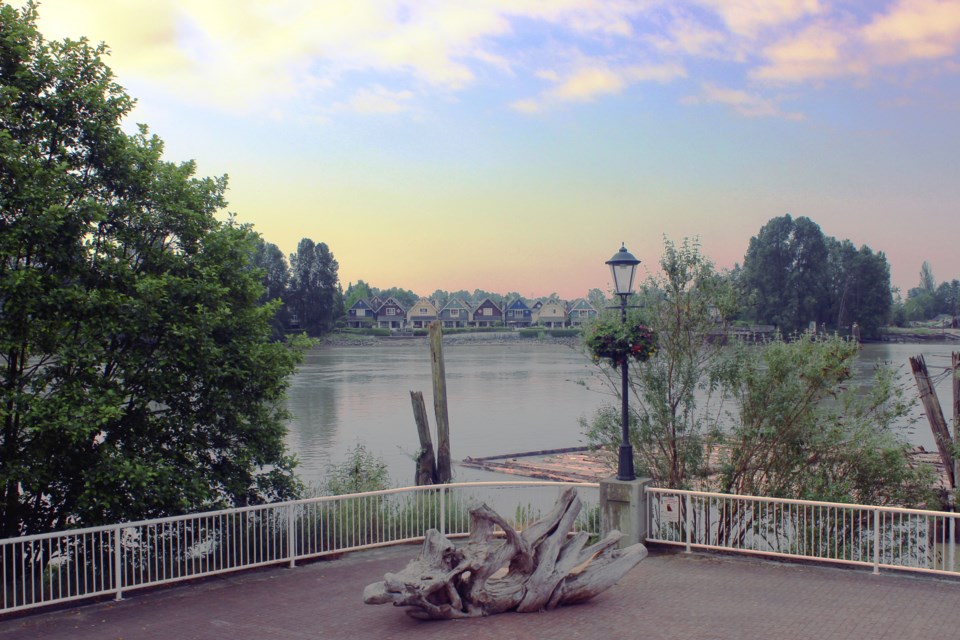A new piece of public art has been unveiled on New Westminster’s riverfront as part of the Vancouver Biennale.
On Thursday, the Vancouver Biennale unveiled the first of three public art installations planned for New Westminster. Public Furniture/Urban Trees, a piece by Brazilian artist Hugo Franca, is now located on the western end of the waterfront esplanade, between Renaissance Square and Reliance Court.
“Although the artist has exhibited his artwork internationally, this was the first time in his 20-year career that he created public sculpture outside Brazil using a variety of local wood species, which makes this a truly unique Biennale project and experience for the artist,” said Vancouver Biennale founder and president Barrie Mowatt in a press release.
According to the Vancouver Biennale, the sculpture highlights the important role of lumber resources to the economy and existence of New Westminster and other cities that continue to thrive along the banks of the Fraser River. Twelve sculptural artworks created by Hugo France will be on display in participating cities as part of the 2014 to 2016 Vancouver Biennale exhibition.
“Since the 1980s, Franca has developed a unique sculpting process which respects and accentuates the natural features of condemned trees, promoting minimum waste while celebrating the beauty of organic curves, line, flaws and imperfections,” said the Vancouver Biennale press release. “The memory of the trees is kept alive through his unique sculptural forms, offered back to the community in a balance between function and form in harmony with the environment.”
The theme of the 2014 to 2016 Vancouver Biennale is Open Borders/Crossroads Vancouver, with the three pieces scheduled for New Westminster aiming to provide a discussion about trade, transportation and the flow of people and resources, as well as sustainability and the natural environment.
“We are excited to be partnering with the Biennale on presenting Open Borders/Crossroads Vancouver,” said Mayor Jonathan Cote. “This exhibition will engage our community in a multitude of conversations that explore who we are as a city, where we’ve come from and where we are going.”
Early last year, New Westminster city council approved three projects as part of the Vancouver Biennale: Blue Trees by Konstantin Dimopolous; Public Furniture/Urban Trees by Hugo Franca; and WOW New Westminster by Jose Resende.
Mowatt recently told the Record that WOW Westminster is the next installation planned for New Westminster. The piece, which generated considerable debate when it was first proposed, consists of four shipping containers positioned in the shape of two Vs.
“I am ecstatic about that. Of all the installations we have done, and we have done some pretty spectacular installations this Biennale, WOW is the coup de grace kind of thing,” Mowatt said. “It’s really, really site-specific work. It’s really dramatic.”
The plan is for WOW New Westminster to be installed on the timber wharf section of Westminster Pier Park. Blue Trees, which features trees whose trunks have been coated with a blue pigment, will be located on Columbia Street, and possibly at city hall.
Although the original concept proposed siting Blue Trees in a one- or two-block section of Columbia Street, Mowatt said the artist has proposed doing something “much more dynamic” that would engage residents to apply blue pigment to trees on the front lawn of city hall.
“He is not talking about planting them in the ground there,” Mowatt stressed. “He is talking about using it as a launching pad where people come together on a public site, help pigment them as a group. He reorganizes them on that site, in the sacks, in some creative and artistic manner and then over a period of months they will remain and the city makes a decision about where they want them to be.”
City staff will soon present council with a recommendation from the city’s public art advisory committee to have a “modest” installation of Blue Trees on the front lawn of city hall, as well as on Columbia Street.
New Westminster’s 2014 budget included $90,000 to participate in the Vancouver Biennale projects, which includes “open-air museums” featuring public art, an education program, an international artists’ residency program, a lecture series and more.
Although the Vancouver Biennale installations were set to begin arriving in New West last fall, Mowatt is thrilled that the city will soon be part of the Vancouver Biennale.
“The good thing is the Biennale runs through 2016, so that’s cool,” he said. “The universe works in mysterious ways. The good part is we can all focus on the spring of 2015 and have more of a wham-bang thing.”



